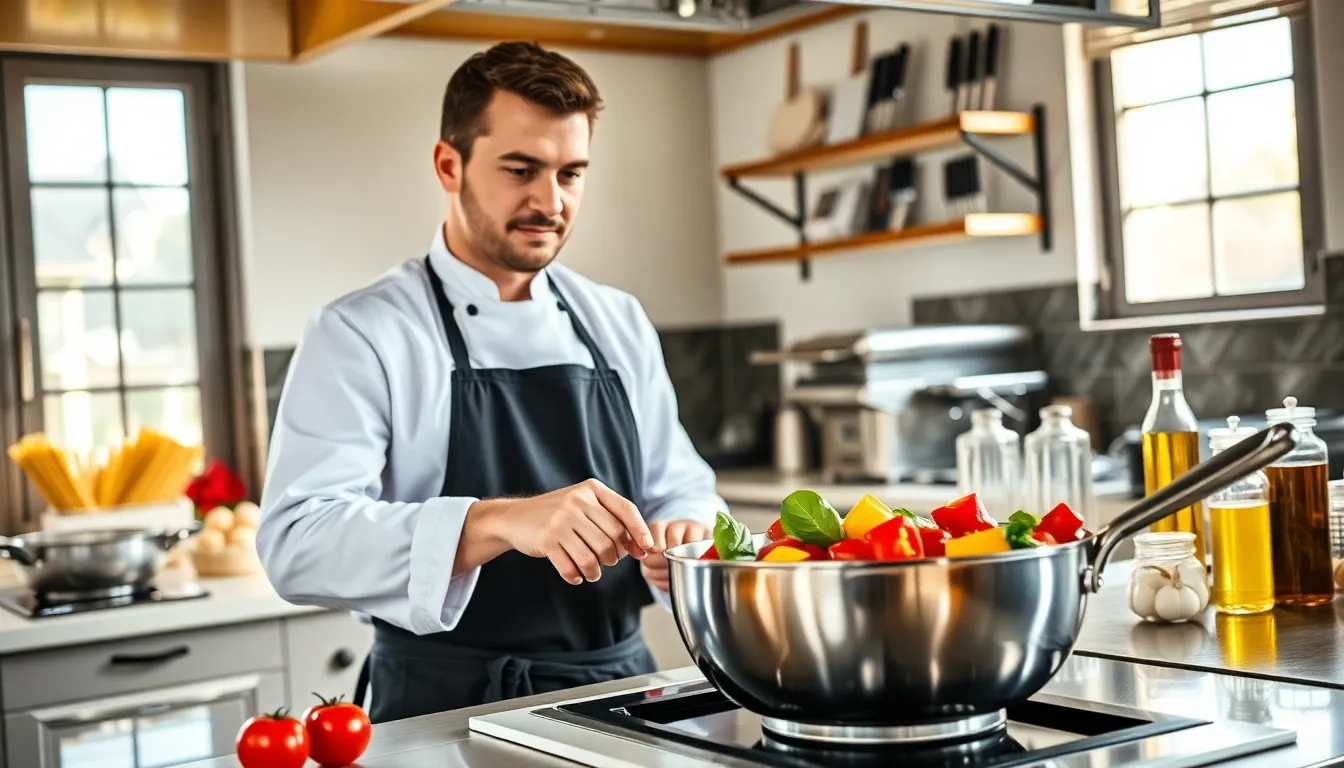If you think cooking Italian means just boiling pasta or tossing some marinara sauce, then buckle up, because there’s a whole world of flavors waiting for you. Italian cooking techniques are an intricate dance of history, culture, and, most importantly, deliciousness. Whether you’re a seasoned home chef or a novice eager to impress dinner guests, understanding the nuances of these techniques can elevate your culinary game to a level that would make Nonna proud. So, grab your apron and let’s jump into the heart of Italian kitchens where every simmer, sauté, and stir tells a story.
Table of Contents
ToggleUnderstanding The Fundamentals

At the core of Italian cooking lies a rich history punctuated by regional diversity, fresh ingredients, and time-honored techniques. Understanding these fundamentals will help any budding chef grasp the essence of Italian cuisine.
First and foremost, Italians hold a strong belief in cooking with freshness. Seasonal and high-quality ingredients are the heartbeats of any dish. Whether it’s ripe tomatoes from the summer fields or earthy mushrooms in fall, the quality of your ingredients can make or break a meal. It’s no secret that the best risottos come from perfectly aged Arborio rice, and the flavor of fresh basil can light up a classic tomato sauce like nothing else.
Another aspect worthy of note is simplicity. Italian kitchens cherish simplicity, an ethos captured beautifully in the phrase “less is more.” A handful of quality ingredients, when treated with respect, can yield stunning results. Think Caprese salad, mozzarella, tomatoes, basil, and a drizzle of olive oil, easy but bursting with flavor.
Finally, nothing speaks Italian cooking like patience. Many traditional dishes, like ragù, require slow cooking to allow the essential flavors to meld and thrive. The magic of Italian cooking often lies in the time taken to prepare, cook, and enjoy the meal with loved ones.
Key Ingredients And Tools
Mastering Italian cooking means becoming close friends with a few key ingredients and tools. They’re the unsung heroes of every Italian kitchen, working together to create magic that would make anyone say ‘mangia’.
- Olive Oil: Italians elevate olive oil to an art form. A drizzle of high-quality olive oil can uplift even the simplest of dishes, providing rich flavor and depth.
- Garlic: You can’t have Italian cuisine without garlic. It’s the aromatic cornerstone that kicks off many delicious recipes.
- Fresh Herbs: Basil, parsley, and oregano are staples. They not only add flavor but elevate presentation.
- Pasta: The ultimate canvas for flavors, making fresh pasta might seem daunting, but the process is part of the charm.
- Cheese: Parmigiano-Reggiano isn’t just cheese: it’s a sprinkle of Italian magic on top of countless dishes.
As for tools, consider investing in:
- A good-quality knife for precise chopping and slicing.
- A cast iron skillet for stovetop-to-oven versatility.
- A pasta maker to create fresh, homemade pasta.
- A mandoline slicer for perfect vegetable prep, ensuring uniformity in size and cooking.
Traditional Cooking Methods
Tradition is the backbone of Italian cooking. Without it, countless beloved dishes would never grace our tables. Here are some traditional cooking methods that define Italian cuisine:
- Sautéing: A quick and efficient method, sautéing is all about high heat and quick cooking. It’s perfect for bringing out the flavors of vegetables and proteins alike.
- Braised Cooking: Slow-cooking tougher cuts of meat makes them tender and flavorful. This technique, often seen in dishes like Osso Buco, is a true family favorite.
- Baking: Italians have a love affair with baking, whether it’s savory focaccia or sweet tiramisu. The result? A comforting embrace of flavors and aromas that brings everyone to the table.
- Grilling: Cooking over an open flame is central to many Italian dishes, particularly in coastal regions: the char and smokiness bring out fresh flavors like nothing else.
Modern Adaptations Of Classic Techniques
While tradition lays the groundwork, innovation breathes new life into Italian cuisine. Chefs today are redefining classic techniques with modern twists. Consider these contemporary adaptations:
- Sous-vide Cooking: This technique allows for precision, usually enhancing flavors without overcooking. Meats cooked sous-vide can melt in your mouth, taking traditional methods to a whole new level.
- Fusion Flavors: Mixing Italian with ingredients from other cuisines is also on the rise. Think spaghetti tacos or pizza topped with exotic ingredients like kimchi.
- Plant-Based Variations: The modern culinary landscape embraces plant-based diets, leading chefs to create meatless versions of traditional favorites like mushroom ragù or zucchini lasagna.
- Deconstructed Dishes: Deconstructing classic dishes lets chefs play with presentation and flavor combinations while challenging perceptions of familiar favorites.
Regional Variations In Cooking Techniques
One of the most fascinating aspects of Italian cuisine is its regional diversity. Each Italian region boasts unique ingredients and methods reflective of its landscape and heritage.
- Northern Italy: Known for its risottos and creamy sauces, butter often replaces olive oil. Think of dishes like polenta or ragu alla Bolognese, a slow-simmered meaty sauce that embodies the region’s comfort food ethos.
- Central Italy: Here, olive oil dominates cooking, with hearty dishes like cacciucco and pasta made from flour and water. The art of preserving meats, such as prosciutto, also shines.
- Southern Italy: Renowned for its vibrant flavors, southern cuisines highlight tomatoes, capers, and olives. Pizza Napolitana is a classic dish that reflects this region’s pride in its simple but flavorful ingredients.
Tips For Mastering Italian Cooking Techniques
Getting comfortable with Italian cooking techniques doesn’t happen overnight. Here are some tips that can accelerate one’s journey to Italian culinary mastery:
- Practice Makes Perfect: Don’t be afraid to fail occasionally. Cooking is as much about trial and error as it is about following recipes. Celebrate the small victories.
- Experiment with Ingredients: While traditionalism has its place, don’t hesitate to experiment with alternative ingredients that excite your palate.
- Take Your Time: Rushing through cooking rarely yields the best results. Allow flavors to meld and develop. Enjoy the process as much as the meal itself.
- Learn From Others: Whether through a cooking class, watching online tutorials, or cooking with friends, learning from others provides invaluable insight.





